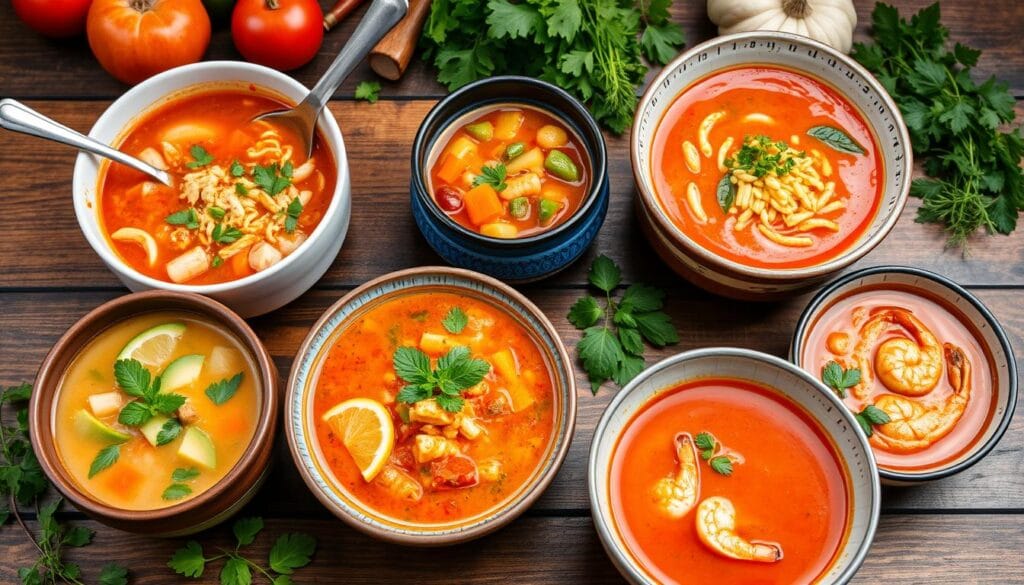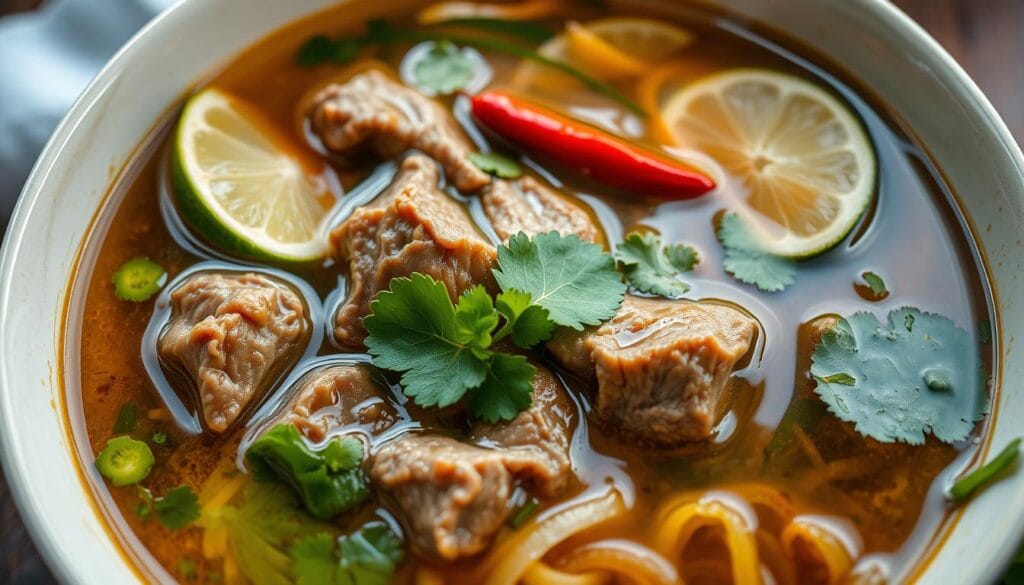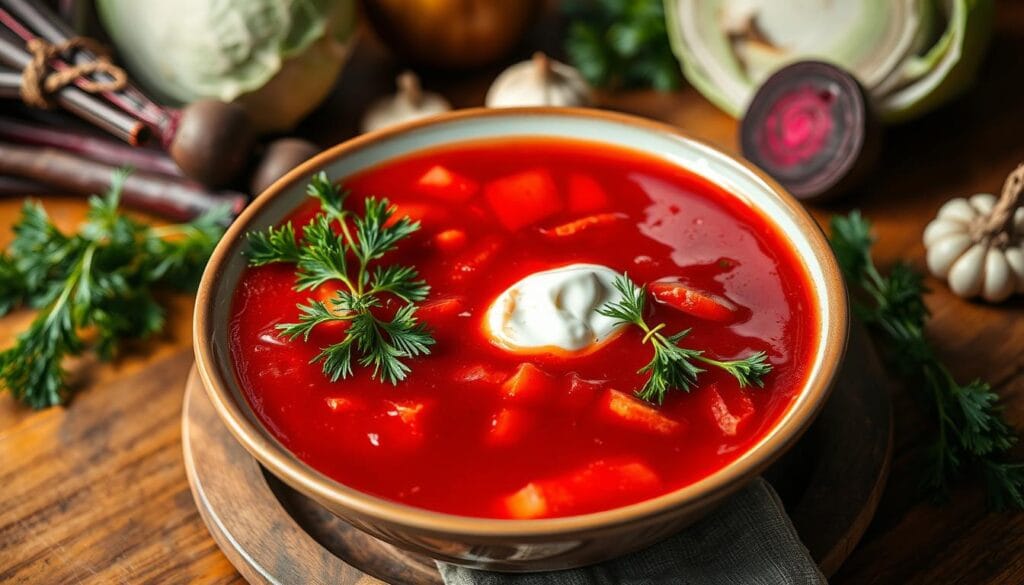When the aroma of soup fills the air, it instantly evokes memories and a sense of comfort. More than just food, soup is a tradition handed down through generations, reflecting the unique tastes and cooking styles of diverse cultures.
For instance, from Vietnam’s fragrant pho to Ukraine’s hearty borscht and Thailand’s zesty Tom Yam, the world offers an incredible variety of soups. These dishes not only delight our senses but also warm our hearts.
In this article, we delve into the world’s most delicious soups. Specifically, we examine the art of soup-making, its cultural significance, and the remarkable range of flavors. Join us as we uncover the stories and techniques that contribute to each soup’s greatness
Main Highlights :
- Soups are a universal comfort food found in every cuisine around the world.
- Each country has its iconic soup that reflects the region’s cultural heritage and gastronomic history.
- Soups can be prepared in a variety of ways, from brothy and light to thick and hearty, and served hot, cold, or at room temperature.
- The versatility of soups makes them an excellent way to utilize leftovers and inexpensive ingredients.
- The art of soup-making has evolved, with traditional cooking methods and vessels contributing to the unique flavors and textures of each dish.
The Ancient Art of Best Soup Making: A Cultural Journey
Soup has been a vital part of human life for thousands of years, evolving alongside cooking methods and tools. These humble dishes not only showcase local ingredients but have also become deeply rooted in culture and health. But the question remains: what is the most delicious soup in the world?
Historical Significance of Soup in Human Civilization
Soup-making dates back to around 20,000 BC, reflecting the ingenuity of early humans who transitioned from clay pots to cauldrons. This evolution highlights the creativity and resourcefulness of humanity in the quest for flavorful and nutritious food.
Moreover, soups have long served as a unifying force, transcending cultural boundaries. They hold a significant place in many cuisines around the globe, symbolizing shared traditions and communal gatherings.
Evolution of Cooking Methods and Vessels
As technology advanced, so did the art of soup-making. Innovations in cookware, such as improved pots and pans, have enabled chefs to experiment with diverse flavors and textures. Consequently, this progress has expanded the culinary possibilities of soups.
Traditional Healing Properties of Soups
For centuries, soups have been associated with comfort and healing. From chicken noodle soup to restorative ginger broths, they have been trusted remedies during times of illness, providing both nourishment and solace.
Over time, the diversity of soups has grown immensely. Each variety reflects the distinctive ingredients and culinary traditions of its culture. Ultimately, soups have a unique ability to bring people together, demonstrating the profound connection between food and human life.
What is the Most Delicious Soup in the World: A Global Perspective
Finding the world’s tastiest soup is hard because it depends on what people like. TasteAtlas has ranked soups based on over 24,000 real ratings. This gives us a look at the most loved soups around the world.
These rankings help highlight local foods, make people proud of their dishes, and spark interest in new tastes. The list features soups from all over, each with its special flavor and history.
In Puerto Rico, Asopao mixes saffron rice with West African gumbo. Morocco’s Harira is a stew of legumes and vegetables, flavored with warm spices. These soups show how rich and varied global food traditions are. The UNESCO-protected Ukrainian borscht and the sour Sinigang from the Philippines are among the world’s best soups.
| Soup | Country of Origin | Key Features |
|---|---|---|
| Asopao | Puerto Rico | Fusion of saffron rice from colonial Spain and West African gumbo influence |
| Harira | Morocco | A flavorful mixture of legumes and vegetables simmered with warm spices often served during Ramadan |
| Borscht | Ukraine | Deeply ingrained in Ukrainian culinary culture, declared part of Ukraine’s “intangible cultural heritage” by UNESCO in 2022 |
| Sinigang | Philippines | Sour-flavored soup combining rice or taro, fresh vegetables, and proteins soured with fruits like tamarind or guava |
| Laksa | Singapore/Malaysia | Spicy noodle soup with coconut milk broth and seafood claimed as a national dish by both countries |
| Molokhia | Egypt | Thickened soup made with rabbit or chicken broth and greens from mallow plants that release a thickening gel when cooked |
These soups, and many others, have become famous worldwide. They show how much people love the tastiest and most meaningful soups from around the globe.

Vietnamese Pho: A Symphony of Flavors and Aromas
Pho, the iconic Vietnamese soup, shows the country’s rich culinary heritage. It has won hearts worldwide with its diverse flavors. Each city in Vietnam adds its own twist to this beloved soup.
The Perfect Broth: Spices and Techniques for Best Soup
The broth of a good pho is key. It’s made with spices like star anise, cinnamon, and cloves. These spices mix together for a rich flavor.
The broth is simmered for hours. This makes it smooth and full of taste. The bones are cooked slowly to add to the soup’s velvety texture.
Traditional Ingredients and Modern Variations of Best Soup
Pho lets you choose what you like. You can pick from rice noodles, meats, and fresh herbs. This makes it a dish for everyone.
Now, there are fusion pho dishes too. They mix Vietnamese flavors with global tastes. This caters to many different tastes and diets.
Cultural Significance in Vietnamese Cuisine
Pho is more than just food in Vietnam. It’s a symbol of national pride. It shows the country’s strength and is loved everywhere.
In Saigon, pho is eaten all day. In Hanoi, the broth is especially delicate. Pho is a big part of Vietnamese food culture.
The flavors and smells of Vietnamese pho show the country’s rich food history. Whether in a street stall or a fancy restaurant, it’s loved by all. Can we name the Most Delicious Soup in the World?

Ukrainian Borscht: A UNESCO-Protected Cultural Heritage
Ukraine’s borscht is a bright red soup. It’s a UNESCO-protected cultural influence in cooking. This dish is loved for its unique taste and role in Ukrainian culture.
Beetroot gives borscht its bright color and sweet taste. It also has many vegetables, tomatoes, and meat or chicken broth. A dollop of yogurt or sour cream on top adds creaminess.
In 2022, UNESCO named Ukrainian borscht an iconic soup to protect. This shows its deep cultural value in Ukraine. It’s a beloved tradition for centuries.
| Nutritional Value (per 100g) | Amount |
|---|---|
| Proteins | 5.1g |
| Fats | 10.6g |
| Carbohydrates | 7.9g |
| Energy Value | 149 kcal (624 kJ) |
The broth in borscht is full of health benefits. It supports joints, gut health, and skin. Beets and cabbage add antioxidants and anti-inflammatory effects.

Old borscht recipes used beet kvass for a sour taste. Now, lemon juice or sauerkraut are used. This shows the dish’s flexibility and cultural staying power.
Borscht is also good for mental health. Psychologists say warm soups like borscht help emotional health. It’s a comforting cultural influence for many.
French Bouillabaisse: Mediterranean’s Crown Jewel
Bouillabaisse is a legendary seafood soup from Marseille, France. It’s a true gem of the Mediterranean. This dish has a rich history, starting as a simple fisherman’s fare and becoming a gourmet favorite.
Essential Seafood Components
The heart of bouillabaisse is its seafood mix. A traditional Marseille bouillabaisse needs at least four fish types. These include red mullet, conger eel, gurnard, and scorpion fish.
Other seafood like prawns, scampi, and mussels are also used. They add to the flavor and look of the dish.
The Authentic Marseille Recipe
The secret Marseille bouillabaisse recipe is guarded closely. Yet, the core ingredients are known. These are garlic, citrus peel, bay leaf, and saffron.
Saffron gives the soup its golden color and smell. The seafood cooks in a flavorful broth. This creates a perfect mix of tastes and textures. Can we consider it the Most Delicious Soup in the World?
Serving Traditions and Accompaniments
Bouillabaisse is served in two parts. First, the broth is served with toasted bread for dipping. Then, the seafood is served with rouille, a spicy garlic mayonnaise, and lemon wedges.
This way, diners can enjoy the soup’s complex flavors and the seafood’s tender texture.
The famous French bouillabaisse shows the Mediterranean’s culinary greatness. It’s one of the world’s most beloved soups.
Japanese Miso Soup: Umami Excellence
Miso soup is a favorite in Japan, eaten every day. It’s made by mixing fermented miso paste with warm dashi broth. You’ll often find silken tofu and seaweed in it too.
The soup’s flavors vary with different miso types. These range from white to red and yellow. This variety makes miso soup very popular in Japan.
To make the best miso soup, heat the dashi stock gently. Then, mix the miso paste in a separate bowl. This way, the miso’s umami flavor spreads evenly. It also keeps the good bacteria safe from hot temperatures.
There are many dashi types to choose from. Awase Dashi and Iriko Dashi each add their own special taste. This makes miso soup even more delicious.
Miso soup also includes other Japanese foods like silken tofu and seaweed. These add texture and color. They also make the soup healthier.
Miso soup is great for breakfast or as a side dish. Its rich flavors and healthy ingredients make it a true treat. Try making miso soup yourself and enjoy its amazing taste.
Moroccan Harira: A Ramadan Tradition
In Morocco, Harira is a special soup. It’s loved a lot, especially during Ramadan. It’s a big part of the month’s celebrations.
Spice Combinations and Preparation Methods
Harira’s taste comes from spices, herbs, and proteins. It has turmeric, ginger, pepper, parsley, and cilantro. It also has meat like lamb, beef, or chicken. This makes the soup thick and filling.
Making Harira is a careful process. Chickpeas and lentils are soaked overnight. Meat is browned first. Tomatoes are pureed for a smooth base.
The soup simmers for a long time. This lets the flavors mix and the legumes get soft.
Cultural Significance and Serving Customs
Harira is more than food to Moroccans. It’s a key part of iftar, the meal after fasting. Families come together to enjoy it.
Serving Harira is a special tradition. It’s topped with olive oil. These touches make it a celebration of Moroccan culture.
Harira is loved during Ramadan and all year. Its flavors and preparation show Morocco’s rich food culture and traditions. Her another Most Delicious Soup in the World
Thai Tom Yam: Spicy and Aromatic Excellence
Get ready for a taste adventure with Thai Tom Yam soup. It’s one of the world’s tastiest soups. This dish takes you on a journey through Thai flavors.
Tom Yam, or Tom Yum, is a spicy Thai soup. It has lemongrass, combative leaves, fish sauce, chili, onion, and lime juice. These ingredients make it fresh, sour, and spicy. It often has whole shrimp, loved in Thailand and nearby countries.
Making real Tom Yam is all about balance. The broth is key. and made by boiling shrimp heads in water. Then, herbs and spices add to the flavor. There are different versions, like Tom Yam Nam Sai and Tom Yum Nam Khon.
Tom Yam is more than just a soup. It’s a part of Thai culture. It combines shrimp, squid, clams, fish, and mushrooms in a hot, sour broth. It’s perfect for a quick meal or a special feast.
Enjoying Tom Yam is a treat for your taste buds. It’s a mix of spicy and aromatic flavors. Try Thai Tom Yam for a taste of Southeast Asia’s rich flavors.
West African Groundnut Soup: Rich Cultural Heritage
In West Africa, groundnut soup is a beloved dish. It’s made with groundnuts and veggies, showing the area’s rich culture. This soup is both comforting and healthy.
Regional Variations and Ingredients
Groundnut soup recipes differ in West Africa. Yet, groundnuts and veggies are always key. Other ingredients like leafy greens, beans, and meat or fish are added too.
- Leafy greens like Ugwu and Moringa, provide essential nutrients and bold flavors
- Beans and peas, which are versatile ingredients featured in dishes like Akara and Moin Moin
- Meat or fish can add a rich and hearty dimension to the soup
Spices and seasonings also make each soup unique.
Traditional Preparation Techniques
Making groundnut soup is a traditional art in West Africa. Groundnuts are roasted and ground into a paste. This paste is then mixed with onions, tomatoes, and spices.
The soup cooks slowly, blending flavors and thickening. This slow cooking shows the region’s love for detail in cooking.
Groundnut soup is more than just food. It’s a symbol of West Africa’s culture and traditions. It’s a dish that brings people together, celebrating the region’s rich heritage.
Portuguese Caldo Verde: Simple Yet Sophisticated
Portuguese Caldo Verde is a comfort food that’s both simple and sophisticated. It’s a soup made with potatoes, collard greens or kale, olive oil, and sometimes chouriço sausage. It’s a favorite in Portugal and loved worldwide.
The soup is warm and has a great taste, perfect for cold weather. It comes from Portugal’s countryside, where farmers and workers love it. Now, Caldo Verde has new versions with different veggies, greens, and even vegan chorizo.
Caldo Verde is special because it’s easy to make. Potatoes, greens, olive oil, and chouriço mix beautifully. This mix shows off the beauty of Portuguese cooking. You can also add fancy touches like olive oil, smoked paprika, and crispy kale.
Caldo Verde is more than just food in Portugal. It’s a big part of their culture, enjoyed at special times. It’s a comfort food that brings people together. And also popular in places like Brazil and Hawaii, where they add their twist.
If you love trying new famous soup recipes or just want something cozy, try Caldo Verde. It’s a perfect mix of simplicity and quality. Enjoy the taste of Portugal with every spoonful of this Caldo Verde masterpiece.
Conclusion
The search for the world’s most delicious soup takes us on a journey through diverse flavors and cultures. For instance, dishes like Vietnamese Pho and Ukrainian Borscht each tell a story, reflecting unique culinary traditions cherished worldwide.
When it comes to deciding what makes a soup the “best,” opinions differ depending on personal taste. Nevertheless, the shared love for soups highlights their universal appeal. For example, the fragrant spices of Pho and the savory richness of Japanese Miso Soup each offer a unique experience, connecting us to different traditions.
In the end, the question of the “most delicious soup” depends on culture, taste, and personal favorites. Therefore, the journey to find it is less about a single answer and more about savoring the diversity of flavors. So, is there one definitive answer? Perhaps it lies in enjoying them all.
FAQ
What is the most delicious soup in the world?
Finding the world’s most delicious soup is hard. It depends on what you like and where you’re from. TasteAtlas shows us top soups from around the globe. They highlight soups with special flavors and meanings.
What are the different types of delicious soups around the world?
The article talks about famous soups like Vietnamese Pho and Ukrainian Borscht. There’s also French Bouillabaisse and Japanese Miso Soup. Moroccan Harira, Thai Tom Yam, West African Groundnut Soup, and Portuguese Caldo Verde are also mentioned. Each soup has its own taste and cultural story.
What is the cultural significance of some of the world’s most delicious soups?
Soups like Borscht and Harira are deeply rooted in their cultures. Pho is a big part of Vietnamese food worldwide. These soups show off local traditions and the use of local ingredients.
What are the common characteristics of the world’s most delicious soups?
Soups from around the world share some traits. They often use simple, local ingredients. They can be hot or cold, fitting for any time of year.
How have soup-making techniques and traditions evolved over time?
Soups have been important for centuries, changing with cooking methods. The article says soups have many styles and flavors today. Their long history and health benefits keep them loved and valued.

